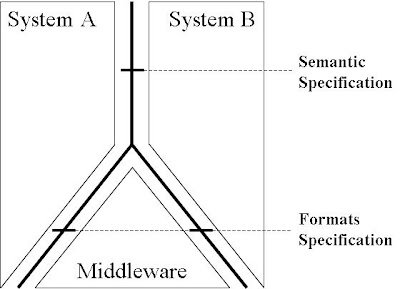A Semantic Integration between applications/systems, is an integration using a shared/common Semantic Specification. A Semantic Specification is the specification of the meaning of the information to be exchanged between the applications/systems to integrate. Once the semantic specification is done, the technical schemas of the interface (e.g. format specification, XML schema, database schema, etc.) of the applications/systems will be respecively mapped/linked to the shared/common semantic specification. Then, the direct technical mapping between the technical schemas of two applications/systems should be "generate" using five inputs:
- The shared/common Semantic Specification
- The format specification, or the technical schema, of the 1st application/system
- The format specification, or the technical schema, of the 2nd application/system
- The links (semantic mapping) between the format specification od the 1st system and the shared/common semantic specification
- The links (semantic mapping) between the format specification od the 2nd system and the shared/common semantic specification
